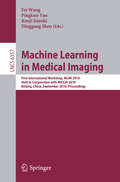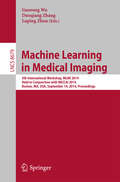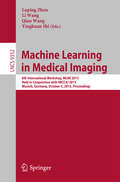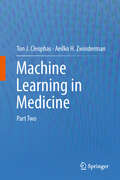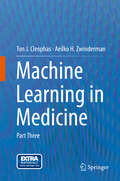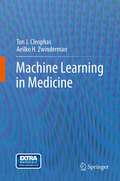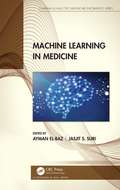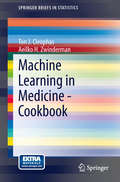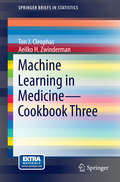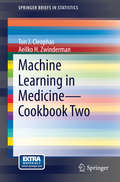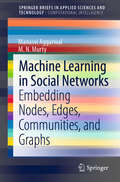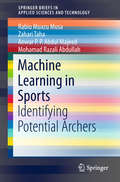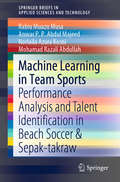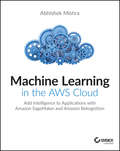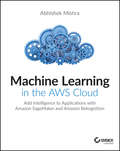- Table View
- List View
Machine Learning in Medical Imaging: 10th International Workshop, MLMI 2019, Held in Conjunction with MICCAI 2019, Shenzhen, China, October 13, 2019, Proceedings (Lecture Notes in Computer Science #11861)
by Heung-Il Suk Mingxia Liu Pingkun Yan Chunfeng LianThis book constitutes the proceedings of the 10th International Workshop on Machine Learning in Medical Imaging, MLMI 2019, held in conjunction with MICCAI 2019, in Shenzhen, China, in October 2019. The 78 papers presented in this volume were carefully reviewed and selected from 158 submissions. They focus on major trends and challenges in the area, aiming to identify new-cutting-edge techniques and their uses in medical imaging. Topics dealt with are: deep learning, generative adversarial learning, ensemble learning, sparse learning, multi-task learning, multi-view learning, manifold learning, and reinforcement learning, with their applications to medical image analysis, computer-aided detection and diagnosis, multi-modality fusion, image reconstruction, image retrieval, cellular image analysis, molecular imaging, digital pathology, etc.
Machine Learning in Medical Imaging: Second International Workshop, MLMI 2011, Held in Conjunction with MICCAI 2011, Toronto, Canada, September 18, 2011, Proceedings (Lecture Notes in Computer Science #7009)
by Kenji Suzuki Fei Wang Dinggang Shen Pingkun YanThis book constitutes the refereed proceedings of the Second International Workshop on Machine Learning in Medical Imaging, MLMI 2011, held in conjunction with MICCAI 2011, in Toronto, Canada, in September 2011. The 44 revised full papers presented were carefully reviewed and selected from 74 submissions. The papers focus on major trends in machine learning in medical imaging aiming to identify new cutting-edge techniques and their use in medical imaging.
Machine Learning in Medical Imaging: Third International Workshop, MLMI 2012, Held in Conjunction with MICCAI 2012, Nice, France, October 1, 2012, Revised Selected Papers (Lecture Notes in Computer Science #7588)
by Fei Wang Dinggang Shen Pingkun Yan Kenji SuzukiThis book constitutes the refereed proceedings of the Third International Workshop on Machine Learning in Medical Imaging, MLMI 2012, held in conjunction with MICCAI 2012, in Nice, France, in October 2012. The 33 revised full papers presented were carefully reviewed and selected from 67 submissions. The main aim of this workshop is to help advance the scientific research within the broad field of machine learning in medical imaging. It focuses on major trends and challenges in this area, and it presents work aimed to identify new cutting-edge techniques and their use in medical imaging.
Machine Learning in Medical Imaging: First International Workshop, MLMI 2010, Held in Conjunction with MICCAI 2010, Beijing, China, September 20, 2010, Proceedings (Lecture Notes in Computer Science #6357)
by Fei Wang Pingkun Yan Kenji Suzuki Dinggang ShenThe first International Workshop on Machine Learning in Medical Imaging, MLMI 2010, was held at the China National Convention Center, Beijing, China on Sept- ber 20, 2010 in conjunction with the International Conference on Medical Image Computing and Computer Assisted Intervention (MICCAI) 2010. Machine learning plays an essential role in the medical imaging field, including image segmentation, image registration, computer-aided diagnosis, image fusion, ima- guided therapy, image annotation, and image database retrieval. With advances in me- cal imaging, new imaging modalities, and methodologies such as cone-beam/multi-slice CT, 3D Ultrasound, tomosynthesis, diffusion-weighted MRI, electrical impedance to- graphy, and diffuse optical tomography, new machine-learning algorithms/applications are demanded in the medical imaging field. Single-sample evidence provided by the patient’s imaging data is often not sufficient to provide satisfactory performance; the- fore tasks in medical imaging require learning from examples to simulate a physician’s prior knowledge of the data. The MLMI 2010 is the first workshop on this topic. The workshop focuses on major trends and challenges in this area, and works to identify new techniques and their use in medical imaging. Our goal is to help advance the scientific research within the broad field of medical imaging and machine learning. The range and level of submission for this year's meeting was of very high quality. Authors were asked to submit full-length papers for review. A total of 38 papers were submitted to the workshop in response to the call for papers.
Machine Learning in Medical Imaging: 4th International Workshop, MLMI 2013, Held in Conjunction with MICCAI 2013, Nagoya, Japan, September 22, 2013, Proceedings (Lecture Notes in Computer Science #8184)
by Guorong Wu Daoqiang Zhang Dinggang Shen Pingkun Yan Kenji Suzuki Fei WangThis book constitutes the refereed proceedings of the 4th International Workshop on Machine Learning in Medical Imaging, MLMI 2013, held in conjunction with the International Conference on Medical Image Computing and Computer Assisted Intervention, MICCAI 2013, in Nagoya, Japan, in September 2013. The 32 contributions included in this volume were carefully reviewed and selected from 57 submissions. They focus on major trends and challenges in the area of machine learning in medical imaging and aim to identify new cutting-edge techniques and their use in medical imaging.
Machine Learning in Medical Imaging: 5th International Workshop, MLMI 2014, Held in Conjunction with MICCAI 2014, Boston, MA, USA, September 14, 2014, Proceedings (Lecture Notes in Computer Science #8679)
by Guorong Wu Daoqiang Zhang Luping ZhouThis book constitutes the refereed proceedings of the 5th International Workshop on Machine Learning in Medical Imaging, MLMI 2014, held in conjunction with the International Conference on Medical Image Computing and Computer Assisted Intervention, MICCAI 2014, in Cambridge, MA, USA, in September 2014. The 40 contributions included in this volume were carefully reviewed and selected from 70 submissions. They focus on major trends and challenges in the area of machine learning in medical imaging and aim to identify new cutting-edge techniques and their use in medical imaging.
Machine Learning in Medical Imaging: 6th International Workshop, MLMI 2015, Held in Conjunction with MICCAI 2015, Munich, Germany, October 5, 2015, Proceedings (Lecture Notes in Computer Science #9352)
by Luping Zhou Li Wang Qian Wang Yinghuan ShiThis book constitutes the proceedings of the 6th International Workshop on Machine Learning in Medical Imaging, MLMI 2015, held in conjunction with MICCAI 2015, in Munich in October 2015. The 40 full papers presented in this volume were carefully reviewed and selected from 69 submissions. The workshop focuses on major trends and challenges in the area of machine learning in medical imaging and present works aimed to identify new cutting-edge techniques and their use in medical imaging.
Machine Learning in Medicine: Part Two
by Ton J. Cleophas Aeilko H. ZwindermanMachine learning is concerned with the analysis of large data and multiple variables. However, it is also often more sensitive than traditional statistical methods to analyze small data. The first volume reviewed subjects like optimal scaling, neural networks, factor analysis, partial least squares, discriminant analysis, canonical analysis, and fuzzy modeling. This second volume includes various clustering models, support vector machines, Bayesian networks, discrete wavelet analysis, genetic programming, association rule learning, anomaly detection, correspondence analysis, and other subjects. Both the theoretical bases and the step by step analyses are described for the benefit of non-mathematical readers. Each chapter can be studied without the need to consult other chapters. Traditional statistical tests are, sometimes, priors to machine learning methods, and they are also, sometimes, used as contrast tests. To those wishing to obtain more knowledge of them, we recommend to additionally study (1) Statistics Applied to Clinical Studies 5th Edition 2012, (2) SPSS for Starters Part One and Two 2012, and (3) Statistical Analysis of Clinical Data on a Pocket Calculator Part One and Two 2012, written by the same authors, and edited by Springer, New York.
Machine Learning in Medicine: Part Three
by Ton J. Cleophas Aeilko H. ZwindermanMachine learning is concerned with the analysis of large data and multiple variables. It is also often more sensitive than traditional statistical methods to analyze small data. The first and second volumes reviewed subjects like optimal scaling, neural networks, factor analysis, partial least squares, discriminant analysis, canonical analysis, fuzzy modeling, various clustering models, support vector machines, Bayesian networks, discrete wavelet analysis, association rule learning, anomaly detection, and correspondence analysis. This third volume addresses more advanced methods and includes subjects like evolutionary programming, stochastic methods, complex sampling, optional binning, Newton's methods, decision trees, and other subjects. Both the theoretical bases and the step by step analyses are described for the benefit of non-mathematical readers. Each chapter can be studied without the need to consult other chapters. Traditional statistical tests are, sometimes, priors to machine learning methods, and they are also, sometimes, used as contrast tests. To those wishing to obtain more knowledge of them, we recommend to additionally study (1) Statistics Applied to Clinical Studies 5th Edition 2012, (2) SPSS for Starters Part One and Two 2012, and (3) Statistical Analysis of Clinical Data on a Pocket Calculator Part One and Two 2012, written by the same authors, and edited by Springer, New York.
Machine Learning in Medicine
by Ton J. Cleophas Aeilko H. ZwindermanMachine learning is a novel discipline concerned with the analysis of large and multiple variables data. It involves computationally intensive methods, like factor analysis, cluster analysis, and discriminant analysis. It is currently mainly the domain of computer scientists, and is already commonly used in social sciences, marketing research, operational research and applied sciences. It is virtually unused in clinical research. This is probably due to the traditional belief of clinicians in clinical trials where multiple variables are equally balanced by the randomization process and are not further taken into account. In contrast, modern computer data files often involve hundreds of variables like genes and other laboratory values, and computationally intensive methods are required. This book was written as a hand-hold presentation accessible to clinicians, and as a must-read publication for those new to the methods.
Machine Learning in Medicine (Chapman & Hall/CRC Healthcare Informatics Series)
by Ayman El-Baz Jasjit S. SuriMachine Learning in Medicine covers the state-of-the-art techniques of machine learning and their applications in the medical field. It presents several computer-aided diagnosis (CAD) systems, which have played an important role in the diagnosis of several diseases in the past decade, e.g., cancer detection, resulting in the development of several successful systems. New developments in machine learning may make it possible in the near future to develop machines that are capable of completely performing tasks that currently cannot be completed without human aid, especially in the medical field. This book covers such machines, including convolutional neural networks (CNNs) with different activation functions for small- to medium-size biomedical datasets, detection of abnormal activities stemming from cognitive decline, thermal dose modelling for thermal ablative cancer treatments, dermatological machine learning clinical decision support systems, artificial intelligence-powered ultrasound for diagnosis, practical challenges with possible solutions for machine learning in medical imaging, epilepsy diagnosis from structural MRI, Alzheimer's disease diagnosis, classification of left ventricular hypertrophy, and intelligent medical language understanding. This book will help to advance scientific research within the broad field of machine learning in the medical field. It focuses on major trends and challenges in this area and presents work aimed at identifying new techniques and their use in biomedical analysis, including extensive references at the end of each chapter.
Machine Learning in Medicine (Chapman & Hall/CRC Healthcare Informatics Series)
by Ayman El-Baz Jasjit S. SuriMachine Learning in Medicine covers the state-of-the-art techniques of machine learning and their applications in the medical field. It presents several computer-aided diagnosis (CAD) systems, which have played an important role in the diagnosis of several diseases in the past decade, e.g., cancer detection, resulting in the development of several successful systems. New developments in machine learning may make it possible in the near future to develop machines that are capable of completely performing tasks that currently cannot be completed without human aid, especially in the medical field. This book covers such machines, including convolutional neural networks (CNNs) with different activation functions for small- to medium-size biomedical datasets, detection of abnormal activities stemming from cognitive decline, thermal dose modelling for thermal ablative cancer treatments, dermatological machine learning clinical decision support systems, artificial intelligence-powered ultrasound for diagnosis, practical challenges with possible solutions for machine learning in medical imaging, epilepsy diagnosis from structural MRI, Alzheimer's disease diagnosis, classification of left ventricular hypertrophy, and intelligent medical language understanding. This book will help to advance scientific research within the broad field of machine learning in the medical field. It focuses on major trends and challenges in this area and presents work aimed at identifying new techniques and their use in biomedical analysis, including extensive references at the end of each chapter.
Machine Learning in Medicine - Cookbook (SpringerBriefs in Statistics #49)
by Ton J. Cleophas Aeilko H. ZwindermanThe amount of data in medical databases doubles every 20 months, and physicians are at a loss to analyze them. Also, traditional methods of data analysis have difficulty to identify outliers and patterns in big data and data with multiple exposure / outcome variables and analysis-rules for surveys and questionnaires, currently common methods of data collection, are, essentially, missing.Obviously, it is time that medical and health professionals mastered their reluctance to use machine learning and the current 100 page cookbook should be helpful to that aim. It covers in a condensed form the subjects reviewed in the 750 page three volume textbook by the same authors, entitled “Machine Learning in Medicine I-III” (ed. by Springer, Heidelberg, Germany, 2013) and was written as a hand-hold presentation and must-read publication. It was written not only to investigators and students in the fields, but also to jaded clinicians new to the methods and lacking time to read the entire textbooks.General purposes and scientific questions of the methods are only briefly mentioned, but full attention is given to the technical details. The two authors, a statistician and current president of the International Association of Biostatistics and a clinician and past-president of the American College of Angiology, provide plenty of step-by-step analyses from their own research and data files for self-assessment are available at extras.springer.com.From their experience the authors demonstrate that machine learning performs sometimes better than traditional statistics does. Machine learning may have little options for adjusting confounding and interaction, but you can add propensity scores and interaction variables to almost any machine learning method.
Machine Learning in Medicine - Cookbook Three (SpringerBriefs in Statistics)
by Ton J. Cleophas Aeilko H. ZwindermanUnique features of the book involve the following.1.This book is the third volume of a three volume series of cookbooks entitled "Machine Learning in Medicine - Cookbooks One, Two, and Three". No other self-assessment works for the medical and health care community covering the field of machine learning have been published to date.2. Each chapter of the book can be studied without the need to consult other chapters, and can, for the readership's convenience, be downloaded from the internet. Self-assessment examples are available at extras.springer.com.3. An adequate command of machine learning methodologies is a requirement for physicians and other health workers, particularly now, because the amount of medical computer data files currently doubles every 20 months, and, because, soon, it will be impossible for them to take proper data-based health decisions without the help of machine learning.4. Given the importance of knowledge of machine learning in the medical and health care community, and the current lack of knowledge of it, the readership will consist of any physician and health worker.5. The book was written in a simple language in order to enhance readability not only for the advanced but also for the novices.6. The book is multipurpose, it is an introduction for ignorant, a primer for the inexperienced, and a self-assessment handbook for the advanced.7. The book, was, particularly, written for jaded physicians and any other health care professionals lacking time to read the entire series of three textbooks.8. Like the other two cookbooks it contains technical descriptions and self-assessment examples of 20 important computer methodologies for medical data analysis, and it, largely, skips the theoretical and mathematical background.9. Information of theoretical and mathematical background of the methods described are displayed in a "notes" section at the end of each chapter.10.Unlike traditional statistical methods, the machine learning methodologies are able to analyze big data including thousands of cases and hundreds of variables.11. The medical and health care community is little aware of the multidimensional nature of current medical data files, and experimental clinical studies are not helpful to that aim either, because these studies, usually, assume that subgroup characteristics are unimportant, as long as the study is randomized. This is, of course, untrue, because any subgroup characteristic may be vital to an individual at risk.12. To date, except for a three volume introductary series on the subject entitled "Machine Learning in Medicine Part One, Two, and Thee, 2013, Springer Heidelberg Germany" from the same authors, and the current cookbook series, no books on machine learning in medicine have been published.13. Another unique feature of the cookbooks is that it was jointly written by two authors from different disciplines, one being a clinician/clinical pharmacologist, one being a mathematician/biostatistician.14. The authors have also jointly been teaching at universities and institutions throughout Europe and the USA for the past 20 years.15. The authors have managed to cover the field of medical data analysis in a nonmathematical way for the benefit of medical and health workers.16. The authors already successfully published many statistics textbooks and self-assessment books, e.g., the 67 chapter textbook entitled "Statistics Applied to Clinical Studies 5th Edition, 2012, Springer Heidelberg Germany" with downloads of 62,826 copies.17. The current cookbook makes use, in addition to SPSS statistical software, of various free calculators from the internet, as well as the Konstanz Information Miner (Knime), a widely approved free machine learning package, and the free Weka Data Mining package from New Zealand.18. The above software packages with hundreds of nodes, the basic processing units including virtually all of the statistical and data mining methods, can be used not only for data analyses, but also for appropriate data storage.19. The current cookbook shows, particularly, for those with l
Machine Learning in Medicine - Cookbook Two (SpringerBriefs in Statistics #49)
by Ton J. Cleophas Aeilko H. ZwindermanThe amount of data medical databases doubles every 20 months, and physicians are at a loss to analyze them. Also, traditional data analysis has difficulty to identify outliers and patterns in big data and data with multiple exposure / outcome variables and analysis-rules for surveys and questionnaires, currently common methods of data collection, are, essentially, missing. Consequently, proper data-based health decisions will soon be impossible.Obviously, it is time that medical and health professionals mastered their reluctance to use machine learning methods and this was the main incentive for the authors to complete a series of three textbooks entitled “Machine Learning in Medicine Part One, Two and Three, Springer Heidelberg Germany, 2012-2013", describing in a nonmathematical way over sixty machine learning methodologies, as available in SPSS statistical software and other major software programs. Although well received, it came to our attention that physicians and students often lacked time to read the entire books, and requested a small book, without background information and theoretical discussions and highlighting technical details.For this reason we produced a 100 page cookbook, entitled "Machine Learning in Medicine - Cookbook One", with data examples available at extras.springer.com for self-assessment and with reference to the above textbooks for background information. Already at the completion of this cookbook we came to realize, that many essential methods were not covered. The current volume, entitled "Machine Learning in Medicine - Cookbook Two" is complementary to the first and also intended for providing a more balanced view of the field and thus, as a must-read not only for physicians and students, but also for any one involved in the process and progress of health and health care.Similarly to Machine Learning in Medicine - Cookbook One, the current work will describe stepwise analyses of over twenty machine learning methods, that are, likewise, based on the three major machine learning methodologies:Cluster methodologies (Chaps. 1-3)Linear methodologies (Chaps. 4-11)Rules methodologies (Chaps. 12-20)In extras.springer.com the data files of the examples are given, as well as XML (Extended Mark up Language), SPS (Syntax) and ZIP (compressed) files for outcome predictions in future patients. In addition to condensed versions of the methods, fully described in the above three textbooks, an introduction is given to SPSS Modeler (SPSS' data mining workbench) in the Chaps. 15, 18, 19, while improved statistical methods like various automated analyses and Monte Carlo simulation models are in the Chaps. 1, 5, 7 and 8.We should emphasize that all of the methods described have been successfully applied in practice by the authors, both of them professors in applied statistics and machine learning at the European Community College of Pharmaceutical Medicine in Lyon France. We recommend the current work not only as a training companion to investigators and students, because of plenty of step by step analyses given, but also as a brief introductory text to jaded clinicians new to the methods. For the latter purpose, background and theoretical information have been replaced with the appropriate references to the above textbooks, while single sections addressing "general purposes", "main scientific questions" and "conclusions" are given in place.Finally, we will demonstrate that modern machine learning performs sometimes better than traditional statistics does. Machine learning may have little options for adjusting confounding and interaction, but you can add propensity scores and interaction variables to almost any machine learning method.
Machine Learning in Molecular Sciences (Challenges and Advances in Computational Chemistry and Physics #36)
by Chen Qu Hanchao LiuMachine learning and artificial intelligence have propelled research across various molecular science disciplines thanks to the rapid progress in computing hardware, algorithms, and data accumulation. This book presents recent machine learning applications in the broad research field of molecular sciences. Written by an international group of renowned experts, this edited volume covers both the machine learning methodologies and state-of-the-art machine learning applications in a wide range of topics in molecular sciences, from electronic structure theory to nuclear dynamics of small molecules, to the design and synthesis of large organic and biological molecules. This book is a valuable resource for researchers and students interested in applying machine learning in the research of molecular sciences.
Machine Learning in Python: Essential Techniques for Predictive Analysis
by Michael BowlesLearn a simpler and more effective way to analyze data and predict outcomes with Python Machine Learning in Python shows you how to successfully analyze data using only two core machine learning algorithms, and how to apply them using Python. By focusing on two algorithm families that effectively predict outcomes, this book is able to provide full descriptions of the mechanisms at work, and the examples that illustrate the machinery with specific, hackable code. The algorithms are explained in simple terms with no complex math and applied using Python, with guidance on algorithm selection, data preparation, and using the trained models in practice. You will learn a core set of Python programming techniques, various methods of building predictive models, and how to measure the performance of each model to ensure that the right one is used. The chapters on penalized linear regression and ensemble methods dive deep into each of the algorithms, and you can use the sample code in the book to develop your own data analysis solutions. Machine learning algorithms are at the core of data analytics and visualization. In the past, these methods required a deep background in math and statistics, often in combination with the specialized R programming language. This book demonstrates how machine learning can be implemented using the more widely used and accessible Python programming language. Predict outcomes using linear and ensemble algorithm families Build predictive models that solve a range of simple and complex problems Apply core machine learning algorithms using Python Use sample code directly to build custom solutions Machine learning doesn't have to be complex and highly specialized. Python makes this technology more accessible to a much wider audience, using methods that are simpler, effective, and well tested. Machine Learning in Python shows you how to do this, without requiring an extensive background in math or statistics.
Machine Learning in Python: Essential Techniques for Predictive Analysis
by Michael BowlesLearn a simpler and more effective way to analyze data and predict outcomes with Python Machine Learning in Python shows you how to successfully analyze data using only two core machine learning algorithms, and how to apply them using Python. By focusing on two algorithm families that effectively predict outcomes, this book is able to provide full descriptions of the mechanisms at work, and the examples that illustrate the machinery with specific, hackable code. The algorithms are explained in simple terms with no complex math and applied using Python, with guidance on algorithm selection, data preparation, and using the trained models in practice. You will learn a core set of Python programming techniques, various methods of building predictive models, and how to measure the performance of each model to ensure that the right one is used. The chapters on penalized linear regression and ensemble methods dive deep into each of the algorithms, and you can use the sample code in the book to develop your own data analysis solutions. Machine learning algorithms are at the core of data analytics and visualization. In the past, these methods required a deep background in math and statistics, often in combination with the specialized R programming language. This book demonstrates how machine learning can be implemented using the more widely used and accessible Python programming language. Predict outcomes using linear and ensemble algorithm families Build predictive models that solve a range of simple and complex problems Apply core machine learning algorithms using Python Use sample code directly to build custom solutions Machine learning doesn't have to be complex and highly specialized. Python makes this technology more accessible to a much wider audience, using methods that are simpler, effective, and well tested. Machine Learning in Python shows you how to do this, without requiring an extensive background in math or statistics.
Machine Learning in Signal Processing: Applications, Challenges, and the Road Ahead
by Sudeep TanwarMachine Learning in Signal Processing: Applications, Challenges, and the Road Ahead offers a comprehensive approach toward research orientation for familiarizing signal processing (SP) concepts to machine learning (ML). ML, as the driving force of the wave of artificial intelligence (AI), provides powerful solutions to many real-world technical and scientific challenges. This book will present the most recent and exciting advances in signal processing for ML. The focus is on understanding the contributions of signal processing and ML, and its aim to solve some of the biggest challenges in AI and ML. FEATURES Focuses on addressing the missing connection between signal processing and ML Provides a one-stop guide reference for readers Oriented toward material and flow with regards to general introduction and technical aspects Comprehensively elaborates on the material with examples and diagrams This book is a complete resource designed exclusively for advanced undergraduate students, post-graduate students, research scholars, faculties, and academicians of computer science and engineering, computer science and applications, and electronics and telecommunication engineering.
Machine Learning in Signal Processing: Applications, Challenges, and the Road Ahead
by Sudeep Tanwar Anand Nayyar Rudra RameshwarMachine Learning in Signal Processing: Applications, Challenges, and the Road Ahead offers a comprehensive approach toward research orientation for familiarizing signal processing (SP) concepts to machine learning (ML). ML, as the driving force of the wave of artificial intelligence (AI), provides powerful solutions to many real-world technical and scientific challenges. This book will present the most recent and exciting advances in signal processing for ML. The focus is on understanding the contributions of signal processing and ML, and its aim to solve some of the biggest challenges in AI and ML. FEATURES Focuses on addressing the missing connection between signal processing and ML Provides a one-stop guide reference for readers Oriented toward material and flow with regards to general introduction and technical aspects Comprehensively elaborates on the material with examples and diagrams This book is a complete resource designed exclusively for advanced undergraduate students, post-graduate students, research scholars, faculties, and academicians of computer science and engineering, computer science and applications, and electronics and telecommunication engineering.
Machine Learning in Social Networks: Embedding Nodes, Edges, Communities, and Graphs (SpringerBriefs in Applied Sciences and Technology)
by Manasvi Aggarwal M.N. MurtyThis book deals with network representation learning. It deals with embedding nodes, edges, subgraphs and graphs. There is a growing interest in understanding complex systems in different domains including health, education, agriculture and transportation. Such complex systems are analyzed by modeling, using networks that are aptly called complex networks. Networks are becoming ubiquitous as they can represent many real-world relational data, for instance, information networks, molecular structures, telecommunication networks and protein–protein interaction networks. Analysis of these networks provides advantages in many fields such as recommendation (recommending friends in a social network), biological field (deducing connections between proteins for treating new diseases) and community detection (grouping users of a social network according to their interests) by leveraging the latent information of networks. An active and important area of current interest is to come out with algorithms that learn features by embedding nodes or (sub)graphs into a vector space. These tasks come under the broad umbrella of representation learning. A representation learning model learns a mapping function that transforms the graphs' structure information to a low-/high-dimension vector space maintaining all the relevant properties.
Machine Learning in Sports: Identifying Potential Archers (SpringerBriefs in Applied Sciences and Technology)
by Rabiu Muazu Musa Zahari Taha Mohamad Razali Abdullah Anwar P.P.Abdul MajeedThis brief highlights the association of different performance variables that influences archery performance and the employment of different machine learning algorithms in the identification of potential archers. The sport of archery is often associated with a myriad of performance indicators namely bio-physiological, psychological, anthropometric as well as physical fitness. Traditionally, the determination of potential archers is carried out by means of conventional statistical techniques. Nonetheless, such methods often fall short in associating non-linear relationships between the variables. This book explores the notion of machine learning that is capable of mitigating the aforesaid issue. This book is valuable for coaches and managers in identifying potential archers during talent identification programs.
Machine Learning in Team Sports: Performance Analysis and Talent Identification in Beach Soccer & Sepak-takraw (SpringerBriefs in Applied Sciences and Technology)
by Rabiu Muazu Musa Anwar P.P. Abdul Majeed Norlaila Azura Kosni Mohamad Razali AbdullahThis brief highlights the application of performance analysis tools in data acquisition, and various machine learning algorithms for evaluating team performance as well as talent identification in beach soccer and sepak takraw. Numerous performance indicators and human performance parameters are considered based on their relevance to each sport. The findings presented here demonstrate that the key performance indicators as well as human performance parameters can be used in the future evaluation of team performance as well as talent identification in these sports. Accordingly, they offer a valuable resource for coaches, club managers, talent identification experts, performance analysts and other relevant stakeholders involved in performance assessments.
Machine Learning in the AWS Cloud: Add Intelligence to Applications with Amazon SageMaker and Amazon Rekognition
by Abhishek MishraPut the power of AWS Cloud machine learning services to work in your business and commercial applications! Machine Learning in the AWS Cloud introduces readers to the machine learning (ML) capabilities of the Amazon Web Services ecosystem and provides practical examples to solve real-world regression and classification problems. While readers do not need prior ML experience, they are expected to have some knowledge of Python and a basic knowledge of Amazon Web Services. Part One introduces readers to fundamental machine learning concepts. You will learn about the types of ML systems, how they are used, and challenges you may face with ML solutions. Part Two focuses on machine learning services provided by Amazon Web Services. You’ll be introduced to the basics of cloud computing and AWS offerings in the cloud-based machine learning space. Then you’ll learn to use Amazon Machine Learning to solve a simpler class of machine learning problems, and Amazon SageMaker to solve more complex problems. • Learn techniques that allow you to preprocess data, basic feature engineering, visualizing data, and model building • Discover common neural network frameworks with Amazon SageMaker • Solve computer vision problems with Amazon Rekognition • Benefit from illustrations, source code examples, and sidebars in each chapter The book appeals to both Python developers and technical/solution architects. Developers will find concrete examples that show them how to perform common ML tasks with Python on AWS. Technical/solution architects will find useful information on the machine learning capabilities of the AWS ecosystem.
Machine Learning in the AWS Cloud: Add Intelligence to Applications with Amazon SageMaker and Amazon Rekognition
by Abhishek MishraPut the power of AWS Cloud machine learning services to work in your business and commercial applications! Machine Learning in the AWS Cloud introduces readers to the machine learning (ML) capabilities of the Amazon Web Services ecosystem and provides practical examples to solve real-world regression and classification problems. While readers do not need prior ML experience, they are expected to have some knowledge of Python and a basic knowledge of Amazon Web Services. Part One introduces readers to fundamental machine learning concepts. You will learn about the types of ML systems, how they are used, and challenges you may face with ML solutions. Part Two focuses on machine learning services provided by Amazon Web Services. You’ll be introduced to the basics of cloud computing and AWS offerings in the cloud-based machine learning space. Then you’ll learn to use Amazon Machine Learning to solve a simpler class of machine learning problems, and Amazon SageMaker to solve more complex problems. • Learn techniques that allow you to preprocess data, basic feature engineering, visualizing data, and model building • Discover common neural network frameworks with Amazon SageMaker • Solve computer vision problems with Amazon Rekognition • Benefit from illustrations, source code examples, and sidebars in each chapter The book appeals to both Python developers and technical/solution architects. Developers will find concrete examples that show them how to perform common ML tasks with Python on AWS. Technical/solution architects will find useful information on the machine learning capabilities of the AWS ecosystem.



